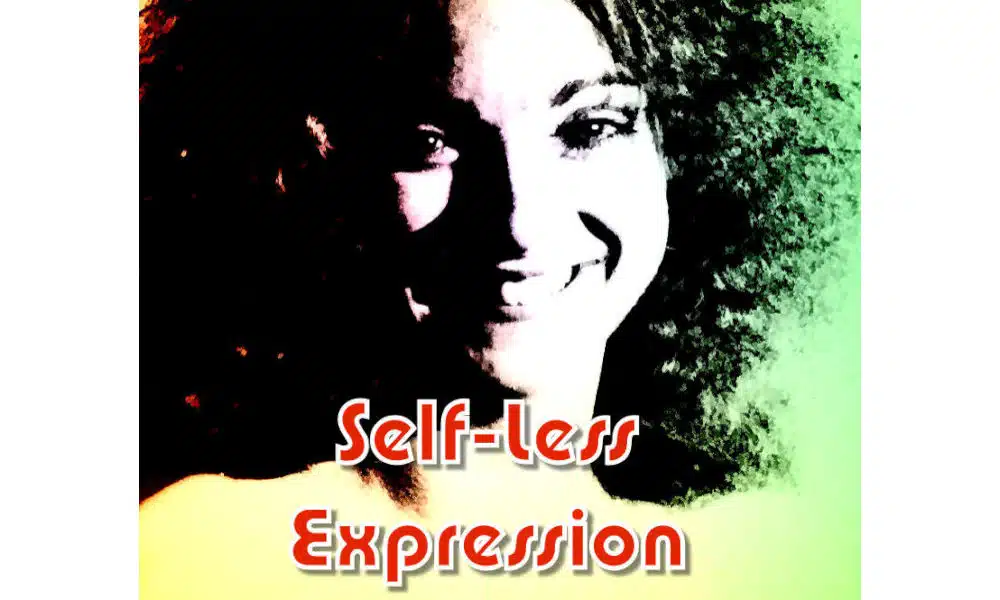Self-less expression is all about speaking your truth without letting your ego get in the way. We find a way to “voice ourselves.”

My first and most popular book,
This Endless Moment.
Learn to live a full and satisfying life.
Today, we turn to the Throat zone — the Zone of Self-less Expression

This zone, runs from below the eyes down to the tops of the shoulders, including the little pocket that you can feel if you push “down and in” in the hollow above each clavicle.
The zone includes
- the back of the neck and the occipital indents
- the two points indicated below the eyes (the “anchor of the social mask,”) and
- the semi-infamous jaw points.
In other words, lots of picky little points, most of which hurt when you push on them.
This Zone is about expression. (Preferably self-less!)
This zone is where you enact what you have learned about yourself.
The process of human development, at its best, (which happens for precious few people, because of the work involved…) is contained in Ken Wilber’s famous concept, “transcend and include.”
What this means is, at each step along the way, we have something to learn that we must also take with us.
To put it baldly, the goal is not to figure out we have a body, only to “give it up,” and become all spiritual. It’s about accepting ourselves exactly and precisely as we are.
And then, finding a way, or multiple ways, to be (to enact… to express) the totality of who we are.
I’m always reading books by Osho. In his “The Book of Secrets,” Osho’s book on Tantra, he mentions that he read somewhere that Freud thought all people were neurotic–and were born that way. Osho disagreed.
Osho says that we are all born natural, and are turned neurotic by our upbringing. The neurosis comes as our cultures force us to split ourselves into pieces.
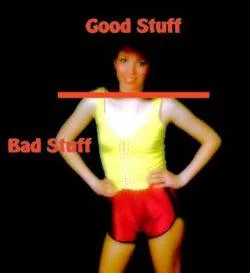
you’re looking at my eyes!
Osho uses the example of parents getting their infants to stop crying. This is really the first split — splitting off the body (feelings) from the mind (thinking.)
What the child learns is that if she cries she creates a disturbance for others, and is “rejected.”
Now, clearly, the parent is disturbing himself — the child really has nothing to do with it.
I was speaking with a friend yesterday, and she mentioned that she had been babysitting a couple of girls. The girls fight a lot, and my friend described being torn between walking out of the room and stopping the fights.
Notice the judgment: fighting is ‘bad / a disturbance.” (Or better put, my friend disturbs herself when witnessing fighting.) So, she created two options for herself. Walking away, or stopping the fighting.
I suggested that she could create a third option, which is to sit there and simply witness the girls fighting, (while maintaining a “no hitting, no hurting” posture) until they finished.
If she tried this, and if she stayed fully aware, she’d notice how she is upsetting herself over her imaginings about how “bad” fighting is.
Her tendency, as it is with most of us, is to either
- run away from things we bother ourselves over, or
- try to get others to stop doing what we bother ourselves over.
Being a simple Zen guy, it seems to me easier to stop bothering myself.
Anyway, the first “split off” for most of us is how we split off from our body and emotions. Most people see themselves “catching their emotions from others,” rather than simply having them. “He makes me so angry” is how this worldview is stated.
The mature, adult view we are promoting is this: “I am making myself angry, and here is how I am going to choose to express it in a safe and elegant way.”
This approach is what begins the healing process — the rejoining of all of the parts of ourselves into a coherent whole.
Most people think of expression as endlessly flapping their lips and expecting the world to give a damn.
“The mass of men lead lives of quiet desperation.”
Henry David Thoreau, “Walden”
The quiet desperation most people live in is the desperation of trying to bend others and the world to their will — and endlessly failing.
Or, trying to figure out what other people want, and endlessly giving it to them, in the vain hope that this will somehow make everyone happy, healthy, and disaster proof.
The alternative, the scary, scary alternative, is to, in the title of the old song, “Express Yourself.”
Instead of tightening down and repressing yourself, you take the risk to open up and be fully human.
This is not a prescription to be yourself. Your “self” is what gets you into trouble in the first place.
Thus, self-less expression
As hard as this is to accept, your “self” is a mental construct, and a series of habits. No matter what you believe, the only person you are is the person you are right now. And now. And now.
The only place you have ever been is here.
And at the same time, you’ve never been here before.
The key to this article, and perhaps the key to your entire existence is this:
This is it.

Think about it. How much time, money, and effort have you expended trying to have what is called a peak experience — a “once-in-a-lifetime,” earth and self shaking moment?
You might even remember, up there in your twisted little mind, a couple of events that you so classify. So, you try, and try, and try, and think, think, think, hoping for “the biggie,” the killer “once-in-a-lifetime event.
Well, the joke’s on you.
Every single moment of every single life is, and only is, and can only be, a once-in-a-lifetime experience.
You’re endlessly living through, without noticing, what you think you’re waiting for!
Please, understand. This is not semantics. This is the way it is.
We waste our lives, our moment-by-moment moments, thinking about past moments, and dreaming about future moments.
“Yeah, but that moment was better than this moment, and the next moment will be better than the moment I had a moment ago. Don’t you know anything?”
And somehow, this idiocy never quite works out. (You think??)
And have you noticed your mind’s habit, in the midst of a peak experience? You’re saying to yourself, “Boy, is this ever great! And the next time will be even better!” And boom, you’ve gone up into your head again.
The Expression zone calls us into being, just being.
- It calls me into knowing who I am, in this moment, experiencing my experiences. When thinking, say, “I am thinking,” or better, “Thinking.”
- I am tuned into my body, to its aches, to pain, to pleasure, to the joy of simply being alive. Moment by moment.
- If I notice that I am resisting acting, out of fear of getting it wrong, I recognize that not acting is acting. Rather than do nothing, I choose a path and take a step.
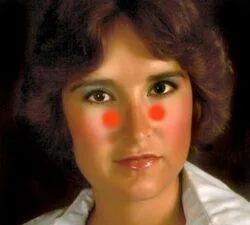
Locate these two points on your face.
They are called, poetically, the anchor points for the social mask.
This, from a Bodywork perspective, is where we anchor our act.
This is the pressure release point for all of the rules and roles society has stuffed down your throat, and which you so willingly swallowed.
It’s the home of labels — like father, mother, son, daughter, husband, wife, child, parent — each of which comes with a specific set of socially approved behaviors.
You may have strained against the tight bindings of these set behaviors, perhaps unconsciously.
But strain you must, because you never have been, you are not now, and never will be, a role.
So, spend a bit of time inserting your index fingers into these points; push down, and see what comes up.
During Bodywork, much time is spent in the Zone, and especially on the jaw points.
It’s a tough area to work with, because it gets really sore, really quickly.
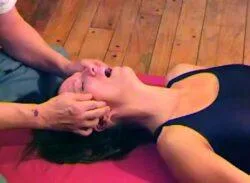
In both Bodywork and Breathwork, pressure is applied to the jaw points.
Most people have really tight jaws, as they spent their entire lives repressing the expression of their true natures.
We are all whole, healthy, alive–and we’ve been persuaded that sharing this is the dumbest thing we could do. So we clamp down On our jaws, and elsewhere,) tighten up, hurt ourselves, and find ourselves incapable of expressing the truth of ourselves.
So, thumbs on jaw points, y’all!
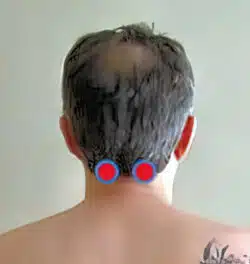
Many people, the day after a Bodywork session, report what they call a base of the skull headache. The occipital indents are another really sore place for people, and I think it’s the height of irony that those little dents are exactly and precisely thumb-shaped.
It’s almost as if we were designed to have someone shoving their thumbs into our occipital indents.
If those areas are tight and sore, I suggest that it’s because that person over-thinks and under-lives. And this includes almost everybody.
Work on your own occipitals, or ask a friend to. Same with the other points.
We have been conditioned to attribute meaning to everything.
It’s what our brains do best. Used efficiently, it’s a great thing. No one wants to have to learn from repeated experience not to step out in front of a bus.
But living our lives in our heads, endlessly planning, plotting, wishing, and hoping, gets us a life lived in our heads. This is not to judge that as bad.
It’s just to repeat that living your life in your head
is not the same as living your life.
This all seems so logical, and I’m sure most of you are totally agreeing with me. And I’ll bet most of you want to spend some time thinking about what I’ve said. And there you go again.
Bye-bye — off into your little head.
It’s sad, really — I’ll miss you.
I know that you know that the only place we can hang out is right here, right now. And the only thing I can do right now is to be totally present as I write this. You’re going to do what you’re going to do.
But if I were sitting opposite you, I’d be saying the following,
“I’m here with you, and you’re here with me, and all that exists, for you and for me, is this space, this time, and you, and me.”
Some Quickie Exercises to help with Self-less expression
Do a little Bodywork on yourself.
You can easily reach your jaw points and your occipital indents.
Notice how often you shut yourself down.
Notice:
- when you have a sense, a felt sense ‚that you should do something, and you pop up into your head and talk yourself out of it, or
- you decide that this time, you really, really are going to do it, but not until you’ve planned it, dissected it, perfected it. In other words, you lie to yourself.
- The real goal is to stop lying to yourself, to stop telling yourself what you’re going to do some day when all your ducks are in a row — when the kids are grown, when your partner is less of a pain in the neck, when you have more time, or money, or experience. Stop lying to yourself. The only time you can do anything is now, so it might as well be this now.
So, instead, make contact.
Notice how often you want to reach out and make contact, and physically share with another who you are and what you’re about right now. Notice all the excuses you come up with for not doing this, or for doing it tentatively, lamely, or partially.
Give yourself a shake, stop making excuses and enact yourself.
Be self-less — Have “No Self”
Even if you don’t really believe this, tell yourself that you have no self.
Nothing of you is substantial and permanent. You can see this clearly, if you will answer this question: where is the eight-year-old version of you?
At no level does any part of the “you” who you were back then exist, in any way, now. Even at the cellular level, every cell in your body is different.
You want to pretend that there’s some kind of continuity between your eight-year-old self, and your present self but it’s just a convenient fiction. This is at once scary and true.
Once you get this, you realize that the only place that you are, the only place you can be is right here, right now. This is it. And this is it. And this is it. Until we die. The only “it” you have to exist in is the one you are in. What are you waiting for?
